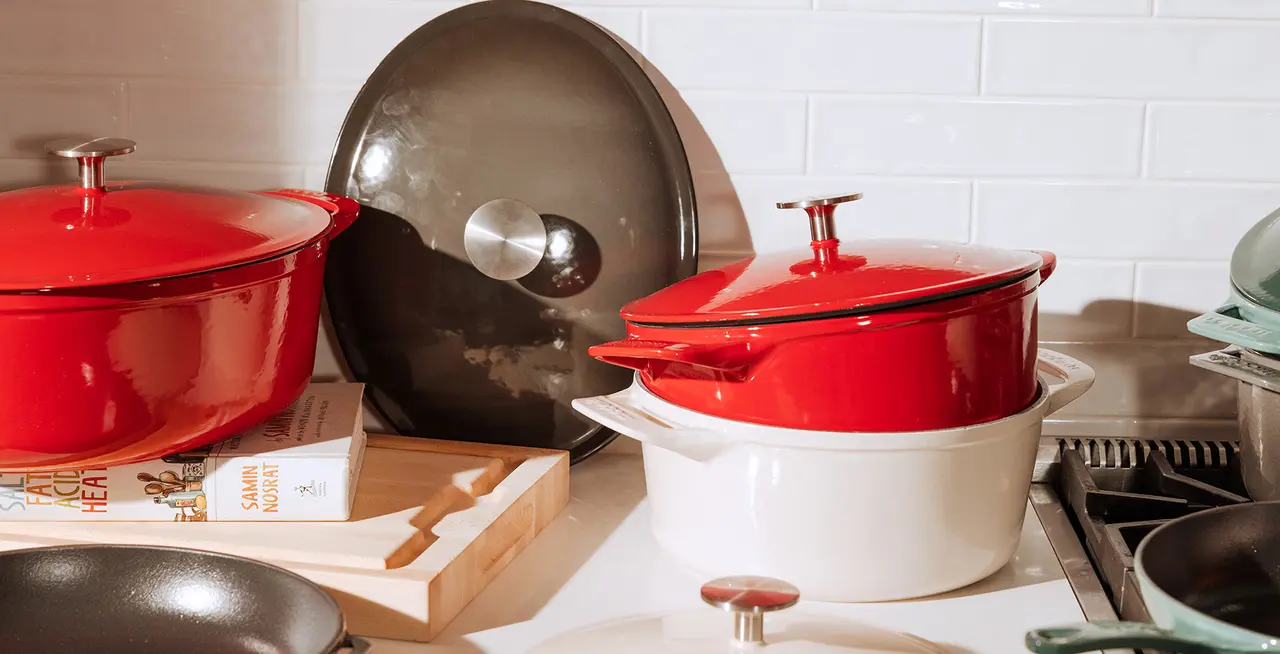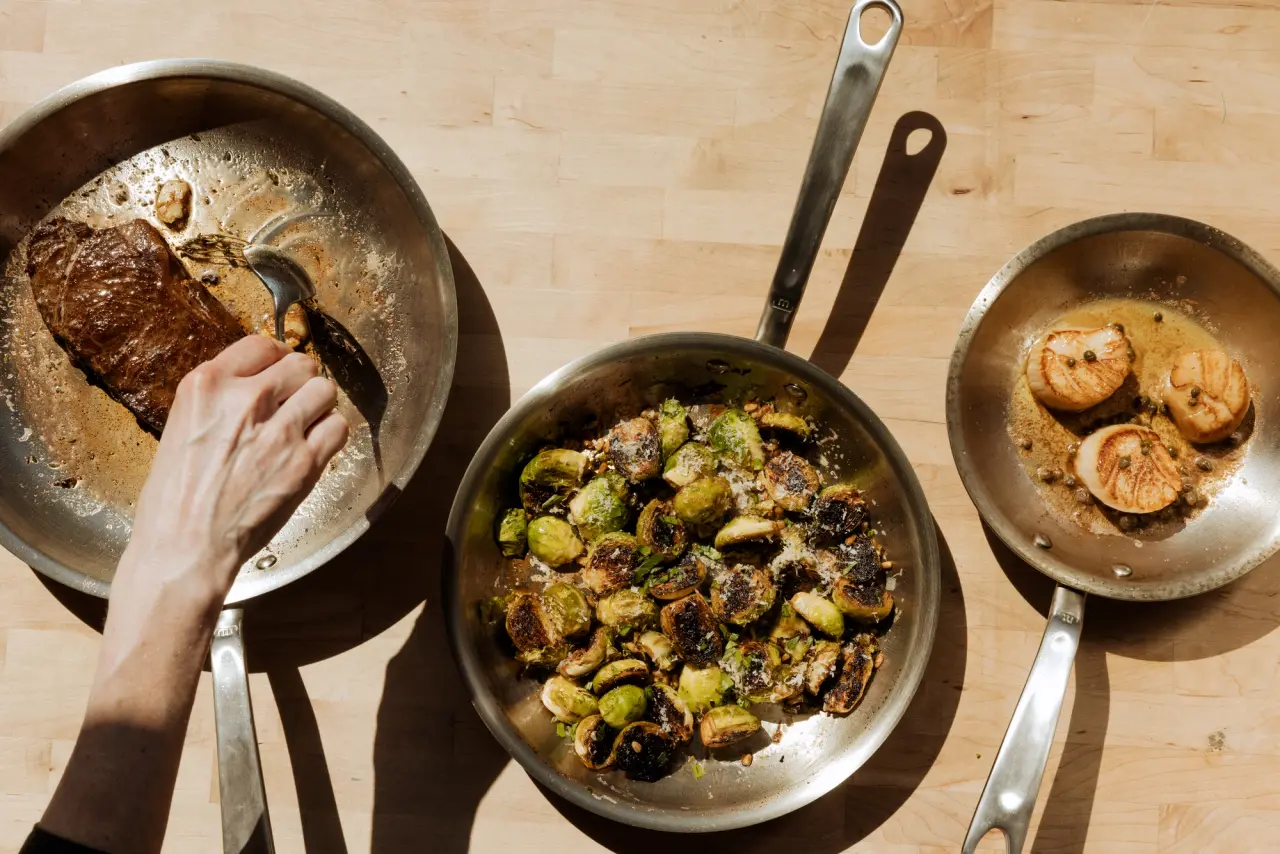Made In's Stainless Clad Cookware is what first earned us a place in professional kitchens. It’s versatile, durable, and reliable. To make sure you’re getting the best results with your stainless pots or pans, we’ve compiled—and answered—your most frequently asked questions below. Let's get into it.
- What Are the Benefits of Stainless Clad Cookware?
- What Does “Clad” Mean In Cookware?
- What Is 5-Ply Cookware?
- Is Stainless Clad Cookware Non-Toxic?
- How Do You Cook With Stainless Clad Cookware Without Everything Sticking?
- How Do You Clean and Care for Stainless Clad Cookware?
- Is Stainless Clad Cookware Dishwasher Safe?
- Will Stainless Clad Cookware Work on All Stovetops, Including Induction?
- How Does Stainless Clad Cookware Compare to Carbon Steel and Non Stick?
- What Is the Best Stainless Clad Cookware Set for the Money?
- Ready to Shop?
What Are the Benefits of Stainless Clad Cookware?
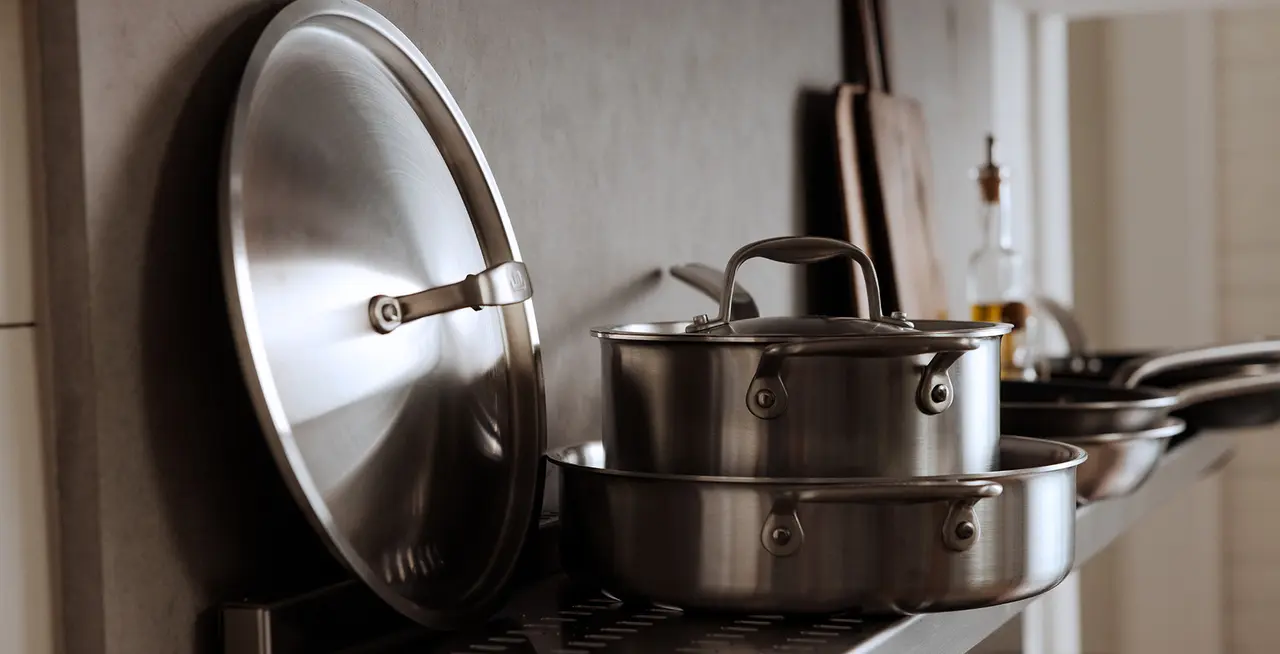
Stainless clad cookware delivers an ideal balance of durability, versatility, and performance. Built with multiple layers of stainless steel and an aluminum core, it’s designed to last a lifetime without warping, rusting, or staining. The stainless steel surface is non-reactive and chemical-free, so it won’t leach or alter the flavor of acidic foods, making it a safe and reliable choice for everyday cooking.
Equally important is its cooking performance and flexibility. The aluminum core distributes heat evenly across the pan, preventing hot spots and giving you precise temperature control for searing, sautéing, simmering, or frying.
What Does “Clad” Mean In Cookware?
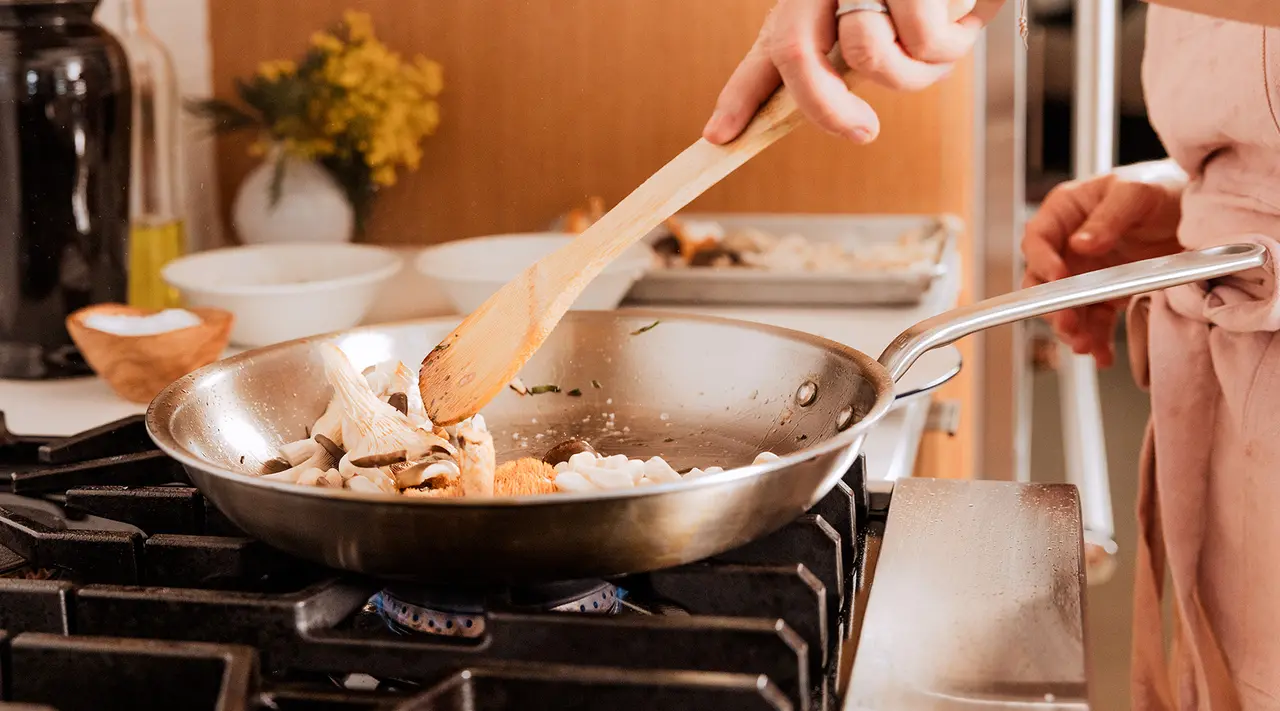
Cladding refers to how the metal is fabricated and layered during the manufacturing process. Made In clads an aluminum and aluminum alloy core with two different layers of premium stainless steel in order to capture the high temperature capabilities of aluminum with the superior heat conduction of stainless steel. The result is our Award-Winning 5-Ply Construction that heats evenly and quickly.
With cheaper cookware, you’ll often find a “sandwich bottom” that’s simply pasted on at the end of manufacturing. It’s a way to save money while still retaining some of the benefits of high quality stainless cookware, but it leads to uneven heating and poor conductivity. Cladded cookware is much more consistent but typically costs more because it’s bonded throughout the pan, not just at the bottom.
What Is 5-Ply Cookware?

“Ply” refers to the number of layers of metal sheets bonded together to create cookware. In stainless clad cookware, you’re usually combining stainless steel (for durability and a non-reactive cooking surface) with aluminum. More plys generally increases heat performance, weight, and durability.
All of Made In's Stainless Clad Cookware is 5-ply, meaning it’s made from five layers of four different metals (304, 18/10 Stainless Steel, Aluminum, Aluminum Alloy, and High Grade Ferritic 430). 5-ply helps the cookware heat up quickly, cook evenly (meaning no hot spots), and respond quickly to changes in temperature.
Each metal serves a distinct purpose. Aluminum contributes excellent heat conduction and almost no weight, and the aluminum alloy (which sandwiches the pure aluminum center) is reinforced with magnesium and manganese to increase its strength and hardness.
The 18/10 stainless steel composes the shiny top surface of our pan. “18/10” means it has a higher nickel percentage, contributing shine and corrosion resistance. It’s also non-reactive, allowing you to cook with acidic ingredients like vinegar, wine, or tomatoes. The bottoms of our pans are made from high grade ferritic 430, another type of stainless steel that’s even more durable and scratch resistant.
Our Stainless Clad Frying Pans have a thickness of 2.7 mm, and the rest of the collection is 2.3 mm thick. The chefs we worked with during the design process told us that was the perfect balance of weight and performance—they found the extra .4 mm of thickness in the frying pans makes them more durable and less likely to burn food.
Is Stainless Clad Cookware Non-Toxic?
All of Made In’s Stainless Clad Cookware is made without: PFAS, PFOA, PTFE, Lead, Cadmium, or BPA and is tested by a third-party under the European Food Contact Safety Regulations. Stainless cookware is non-reactive, coating-free, and safe heated to high temperatures. If you want a clean surface with nothing between you and your ingredients—this is it.
How Do You Cook With Stainless Clad Cookware Without Everything Sticking?
Cooking with stainless clad is hard to get wrong, but there are a few best practices that will set you up for success every time. To ensure your food doesn’t stick and the cookware is easy to clean up, it’s important to pay attention to timing and temperature.
Preheat Your Pan
We recommend letting your pan heat over medium for at least 1–2 minutes before adding cooking fat.
To make sure it’s at the right temperature, you can perform the water bead test by adding a few drops of water directly to the pan. If the droplets form a single bead that dances around the pan, it’s ready. If the water does nothing, it needs more time to heat up. If it explodes and fizzles violently, it’s too hot. Check out the video above to see the water bead test so you know what to look for.
Add Cooking Fat
Once your pan is at the right temperature, add your fat (butter, oil, tallow, etc.) and make sure this gets hot before adding anything else. Many recipes will instruct you to wait until the fat is “shimmering,” which is when the fat spreads out to an even layer and begins to glisten and ripple.
Incorporate Ingredients
At this point, you can begin to add ingredients. In order to get the best sear, they should be at room temperature and as dry as possible. You can test the temperature by slowly lowering the ingredients into the pan. If you immediately hear a gentle sizzle, you can start cooking. If there’s no sizzle, wait a bit longer for the oil to heat up. Be careful of oil splattering, which may occur if there’s residual moisture on your ingredients.
Watch the Heat
Because stainless clad cookware heats quickly and evenly, you’ll find that most things can be cooked over medium to medium-high heat. Tempting as it may be, try not to crank the heat to speed up the cooking. Once your ingredients are in, resist the urge to move them around. Proteins will cling to the surface of the pan as they begin to cook, but will naturally release once fully cooked and crisped.
How Do You Clean and Care for Stainless Clad Cookware?
Cleaning stainless clad cookware is much like cleaning any standard pan. Let your pan cool before cleaning and always hand wash with a sponge, mild soap, and warm water. Dry immediately, and do not put it in the dishwasher. For tough debris or rainbow stains, use our Stainless Steel Cleaner.
Here are a few other tips that will preserve the integrity and appearance of your cookware as long as possible:
- Use care with sharp metal utensils, as they can scratch the surface of your cookware over time.
- To prevent pitting, wait until water is boiling to add salt. Pitting happens when salt reacts with the chromium in your pan, leaving small depressions or spots on its surface. This is purely an aesthetic concern and doesn’t affect your pan’s ability to cook.
- Avoid temperatures over 800F.
- If your cookware has rainbow tint, it is caused by overheating an empty pan. It is a cosmetic issue that does not affect cooking performance and can be removed with a stainless steel cleaner or white distilled vinegar.
- If storing cookware in stacks, separate the pans with cloth or kitchen towel to prevent scratching.
Check out our Stainless Clad care guide for everything else to know about maintaining this cookware.
Is Stainless Clad Cookware Dishwasher Safe?
While technically dishwasher safe, we strongly recommend hand washing our Stainless Clad Cookware. This helps preserve your pan for longer, and avoids harsh chemicals commonly used in the dishwasher. Check out our guide on whether stainless can go in the dishwasher for a deeper dive into the nuances.
Will Stainless Clad Cookware Work on All Stovetops, Including Induction?

Stainless Clad works on any cooking surface—gas stoves, electric burners, flat tops, and induction stoves—and is oven-safe up to 800F.
How Does Stainless Clad Cookware Compare to Carbon Steel and Non Stick?
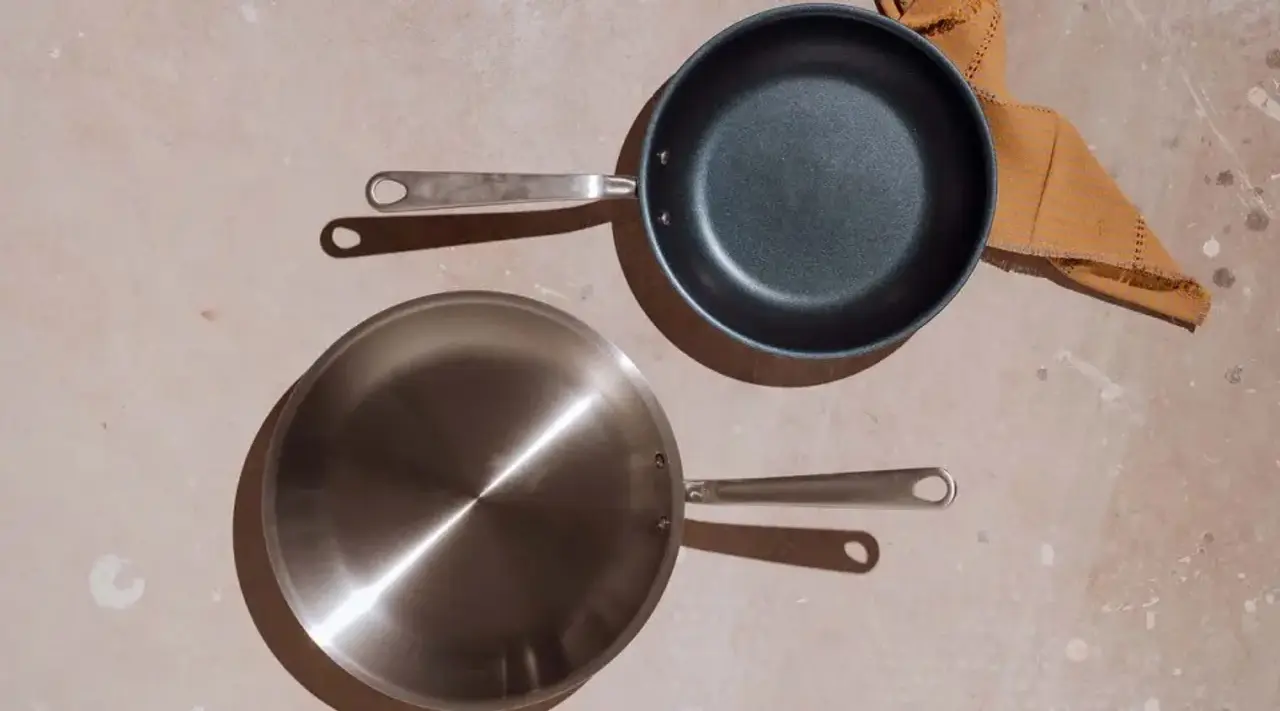
Stainless clad cookware is one of the most popular types of cookware, both in professional and home kitchens. It’s lightweight, affordable, versatile, and relatively low-maintenance. Here are some things to consider when cooking with stainless, and how it compares to both carbon steel and non stick.
Stainless vs. Carbon Steel:
Stainless clad and carbon steel are relatively similar in terms of performance and versatility, but they have a few key distinctions.
Stainless is lighter and non-reactive—meaning that you can cook with acidic ingredients without them imparting a metallic taste. However, carbon steel is more durable and can tolerate higher temperatures (up to 1,200-degrees Fahrenheit).
Carbon steel also requires seasoning and will develop a natural non stick patina overtime, unlike the surface of stainless that remains unchanged. Unlike stainless, carbon steel is reactive and cooking with acidic ingredients can strip its seasoning.
Both can go straight from the stove into the oven, and both conduct, retain, and diffuse heat very well. We recommend having both on hand so you’ve always got the proper tools for the job. For more information, check out our guide on the differences between carbon steel and stainless steel.
Stainless vs. Non Stick:
Stainless cookware is able to perform at higher temperatures (up to 800F) than its non stick counterpart (which can handle up to 500F). Stainless clad pans are also much more resistant to dents and scratches, where non stick is more prone to scratching due to its delicate coating.
Because the bodies of our non stick pans are the same as our stainless clad pans (albeit with two additional layers of professional-quality non stick coating), they perform very similarly. They have the added benefit of being completely non stick right out of the box, where stainless clad cookware may not be the best choice for delicate ingredients like eggs or flaky fish.
Like carbon steel, we recommend thinking of these materials not as competitors, but as complements of a fully stocked kitchen. For a deeper dive, don't miss our comparison of stainless vs. non stick.
What Is the Best Stainless Clad Cookware Set for the Money?
Made In’s 10-Piece Stainless Clad Cookware Set is the chef-curated foundational set your kitchen is missing. Whether you’re looking for the best set for beginners or for more experienced cooks, this assortment of Award-Winning Stainless Clad Cookware will help you craft chef-quality meals, fill the gaps in your kitchen, breathe new life into your routine recipes, and inspire new favorites.
Ready to Shop?
For many chefs and home cooks, Made In's Stainless Clad Cookware is the backbone of the kitchen. It consistently performs, can handle just about everything, and doesn’t require much by way of maintenance. Now that you know everything there is to know about it, the only decision you need to make is: what shape first?





